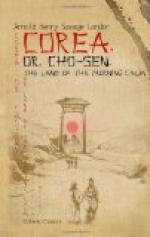Among the lower classes in Corea tea is almost unknown as a beverage. In its stead they delight in drinking the whitish stuff produced by the rice when it has been boiled in water, or as an alternative, infusions of ginsang. They also brew at home two or three different kinds of liquor of different strengths and tastes, by fermenting barley, rice and millet. The beer of fermented rice is not at all disagreeable, and their light wine also is, so far as wines go, even palatable. However, I may as well state once for all that I am no judge of these matters, and, as my time is chiefly employed in the art of oil-painting, and not in that of drinking, I hope to be excused if I think myself better up in “oils” than in wines!!
Presuming that my reader has survived this pun, I will now go on to state that it is a common thing in Corea to begin a dinner with sweets, and that another curious custom is for all present to drink out of the same bowl of wine passed round and of course re-filled when empty. The dinner is served on tiny tables rising only a few inches above the ground, and similar to those of Japan. Fish, as is the case with most Easterners, are eaten raw; first, however, being dipped in the liquid which resembles Worcestershire sauce. To cook a fish is simply looked upon as a shameful way of, spoiling it, unless it has gone bad, when, of course, cooking becomes necessary. Fish are, however, most prized by the Coreans when just taken out of the water.
Hard-boiled eggs form another favourite dish in the land of Cho-sen, and turnips, potatoes, and a large radish similar to the daikon of Japan, are also partaken of at Corean dinners. The poorer classes seem to relish highly a dreadful-looking salad, of a small fish much resembling whitebait, highly flavoured with quantities of pepper, black sauce and vinegar, with bits of pork-meat frequently thrown in. The whole thing has an unpleasant brownish colour, and the smell of it reminded me much of a photographer’s dark room when collodion is in use, except that the smell of the fish-salad is considerably stronger.
The Coreans excel and even surpass themselves in cooking rice. This is almost an art with them, and the laurels for high achievements in it belong to the women, for it is to them that work of this kind is entrusted. Sometimes the Cho-senese make a kind of pastry, but they have nothing at all resembling our bread. Rice takes the place of the last mentioned, and though, so far as I could see, the fair ladies of Cho-sen were somewhat casual in the exercise of the culinary art, they really took enormous trouble to boil the rice properly. It is first well washed in a large pail, and properly cleaned; then it undergoes a process of slow boiling in plenty of water in such a way that, while quite soft and delicious to the taste, each grain retains its shape and remains separate, instead of making the kind of paste produced by our method of boiling it. The whitish water left behind after the rice has been removed is, as we have seen, used as a cooling beverage. In some respects the Corean diet approaches the Chinese and the Indian, rather than the Japanese; for many a time have I seen men in Corea eat their rice mixed with meat and fish, well covered with strong sauce, in the shape of a curry; whereas in Japan the boiled rice is always in a bowl apart and eaten separately.




